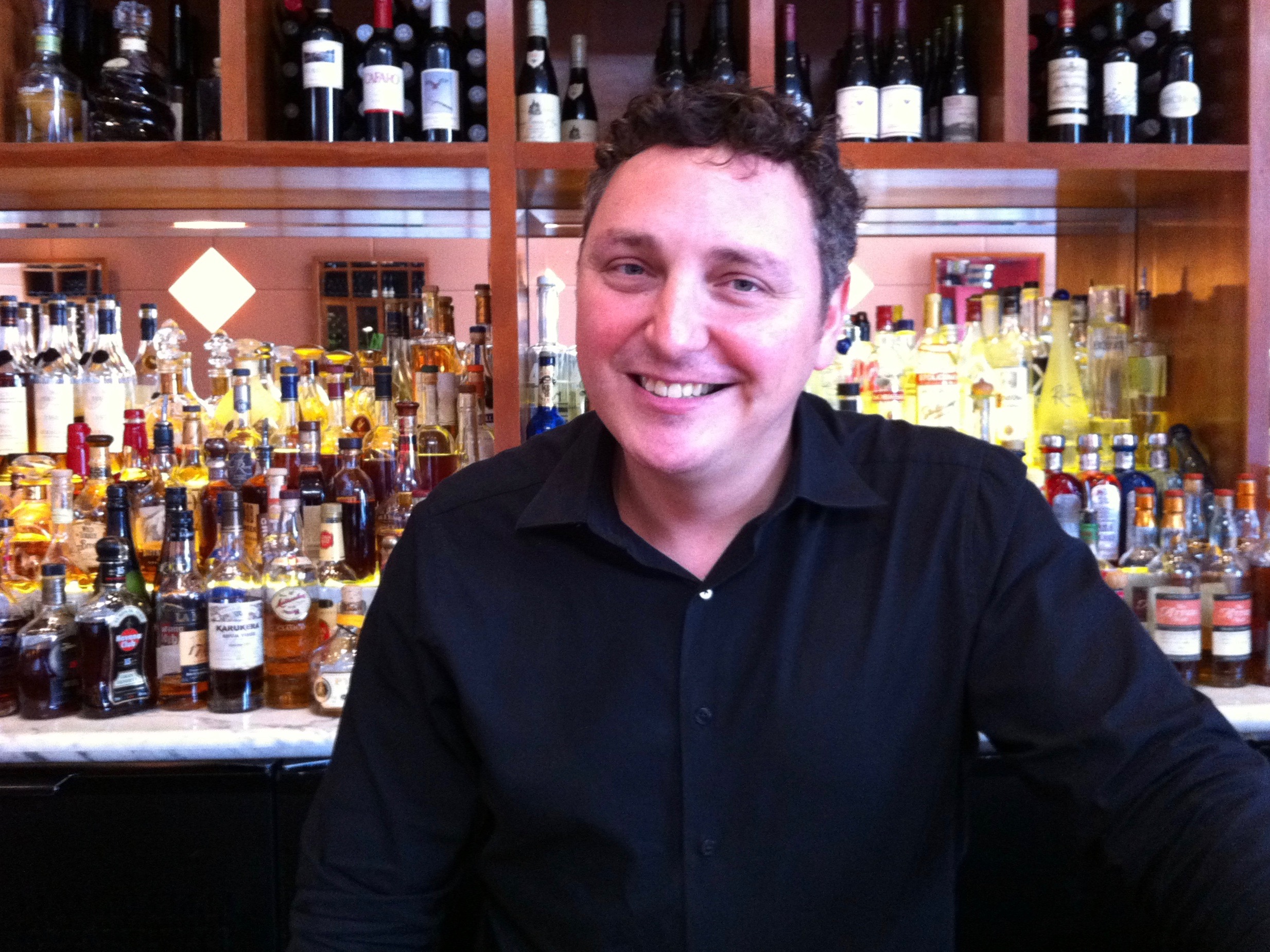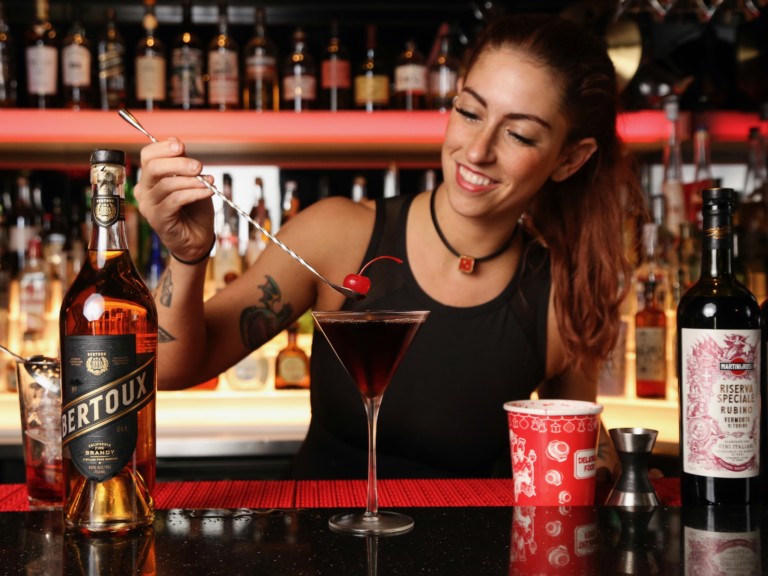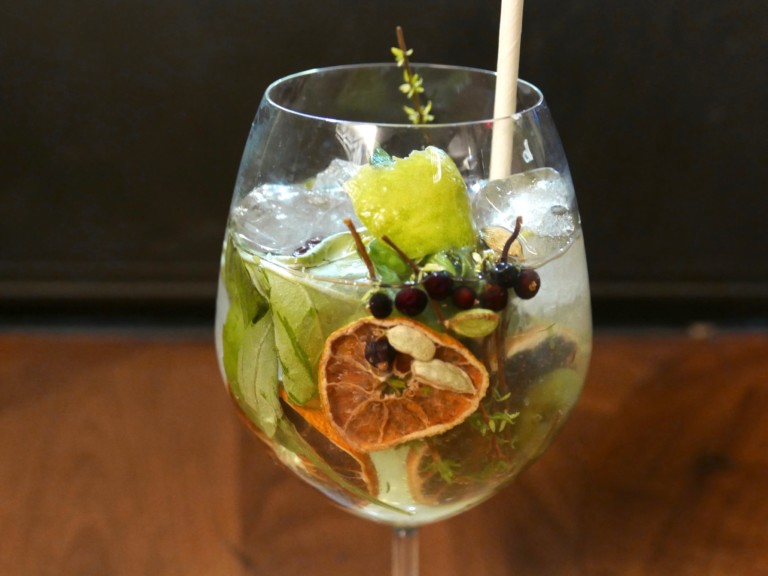So what if David Wolowidnyk started making cocktails for restaurant diners in his teens? That may have been frowned upon by the City of Vancouver – not that they knew – but it gave him a headstart. That experience also allowed him to develop his love of flavors. He’s focused on cocktails, spirits and hospitality ever since, primarily in Vancouver, but also in the Cayman Islands from 1998-2003. On June 4, we met at West, where he better explained his background and approach.
Tell me about the construction of the cocktail menu and the spirits list.
The construction of the cocktail menu and the spirits list was born out of necessity to put down on paper everything that we had back here. When I first arrived at West, we had not an entire listing of all of the wonderful spirits and liqueurs and offerings that the restaurant had. In the six-and-a-half years that I’ve been here, I’ve grown that offering well beyond what we started with, but we needed to put down a listing for the guests so that they could leisurely browse through. Currently, there are over 400 different spirits and liqueurs that are listed on the menu. It makes it much easier for the guests to be aware of what we have, as well as for the staff to know what we have. Otherwise you can imagine the learning curve when the bartender starts here. It’s a journey from just getting to know the program, to finding out where everything is. One of the first things is that every bartender has to help me through inventory at least once, so that they can touch and feel and see every single label that we have, and know exactly where everything is.
What do you look for when you’re hiring somebody to work behind the bar at West?
Work ethic. Passion. I prefer if they have less experience than a lot. I find it’s much easier to instill good habits and proper training through technique than to retrain what they might have been told along the journey, getting to where they’re at in their experience. There are many, many right ways, and I’m not saying that we will ever have the absolute on how we do things. We’re always looking for how we can improve upon what we do, how we do it, but for a person who comes in with a grand amount of experience, it tends to be too hard for them to step into something that has a firm set of systems in place. The instinct is for them to say, “How can I change this?” Versus somebody who’s quite young and eager, and impressionable. They’ll come in first and learn the systems, and over time, they’ll be able to come in with suggestions on how me might improve. I also charge them with the responsibility that every time they go out, I want them to come back with an idea, a thought, perhaps a story about what they’ve seen other people do behind their bar. An impression that they got. Because it might be something that might help us grow as a team. And if it’s a good idea, then we all start doing it that way.
What’s the criteria for a cocktail that goes on the menu?
It’s about the guest. It’s not about us. We take our ideas and the adaptation of the impressions that we get when we got out, or the books we read. But at the end of the day, it’s the guests that are coming into this particular establishment who start to look for a style of drink. When we look at the West Originals page, there’s a diversity of styles, and this is the list of eight or so cocktails long, that changes fairly regularly. Each one of these cocktails is distinctively different.
The first cocktail listed is served over crushed ice in a tall glass. It’s a little bit on the tart side. It will have some sort of seasonal fruit in it…The next drink is an egg white shaken drink that is a little bit tart, with a tiny bit of sweetness…The next one is very similar to a dry martini, keeping it dry with some dry sherry…The next one is bright, summery.
Do you work at all with Chef David Gunawan on cocktails?
Not necessarily on cocktails, but we do work together on pairings. It wasn’t that long ago that we did a cocktail dinner with that same gin company, G’Vine. David, the chef, created this wonderful spring-like menu, because it was right in the middle of spring. When he put this menu together, I looked at the menu and at that point, thought of appropriate pairings to go along with it. We started with this conception. Once the conception was there, then the chef was able to pair those dishes. I was able to prepare at least a mock-up of those cocktails. And then we could work together to try to bring a harmony or balance between the dish and the cocktail. It’s a little bit easier and in a way sometimes harder than doing a wine dinner. The wine doesn’t change. It doesn’t have the ability of changing, because we open that bottle, it’s already essentially a cocktail, a balance between the alcohol, sweetness and the acidity, and it comes in harmony along with, perhaps, a tannic structure. That in a sense is already what a cocktail is trying to mimic. It’s trying to mimic a balance between acidity, sweetness, and alcohol, once again with perhaps a bitter or tannic structure as a backbone, or as an underlying current of balance. We were able to balance those pairings from either side of it, whether it be through the food adjustment, or the cocktail adjustment. We had that freedom of adjusting those pairings either way, which was really quite fun. It was a really successful dinner.
What was one pairing that you think worked especially well?
One pairing that worked especially well was a sablefish dish – sablefish also known in some culinary circles as Alaskan black cod – which is typically smoked. The chef decided not to smoke it. He decided to steam it, and he steamed it over a bed of tea leaves, and cedar strips, also some fresh cedar bows as well, so it imparted this wonderful forced gentle aroma that infused into the fish. Because the fish itself goes so well a smoked element, I decided to infuse some gin with lapsang souchong, which is a smoked Chinese tea. Oranges also go very well with something that is grilled or smoked. You may in your culinary past have tried a slice of grilled orange, or perhaps a burnt orange vinaigrette in a salad. That char or that burn or that smoke can go extremely well with citrus fruits. I decided to take some of that citrus peel and infuse it in with lapsang souchong in the gin. After that, it was a matter of – because the alcohol component was there, the flavor was present – we can simply balance that with the appropriate amount of sweetness and acidity, using citric acid as the acidity instead of lemon or lime juice, cause I wanted to keep the flavor of lemon or lime away. I still wanted to be able to use an acidic component, so using a simple citric acid to achieve the acidic element that dish needed as a complement, so we were bringing this smoke element through the cocktail, because it wasn’t present in the dish. And the tea tied in with the other tea as well.
What was your very first bar job?
Well, it wasn’t one that was legal, so I’ll keep the name out of it.
In Vancouver?
It was in the Vancouver area. I was working for a gentleman who was an old school Frenchman. He was actually born in Spain but raised in France and he had this little restaurant. I started one day as a dishwasher when I was 15 years old. Within six months, he decided to make me a bus boy. Within another six months, by the time I was 16 years old, he had me serving tables in this beautiful little fine dining restaurant with French tableside service, the flaming of toffees at the end of your dinner, to the carving of chateaubriand and the finishing of vegetables tableside. So it was really old school cart style of service, and at 16 years old, I was loving the experience. All of the serving staff were also required to step behind the bar and make drinks for the guests they were serving. So at the age of 16, that was my very first taste of bartending. Why would I not want to do this? It was something that was right up my alley. I was drawn towards the restaurant business because of a love of flavor. Not just a love of flavor of liquid, but a love of flavor from food, to liquid, to the combination of pairing the liquid and the flavor of food together. It was kind of a natural fit. Of course this wasn’t a real job to my parents or anyone else, but it was a real job to me. I ended up staying at this small restaurant for five years. When I was around 20-ish or so, I thought it was time that I started branching out and doing some other things, but that was the birth of it.
What was your very first cocktail memory, good or bad?









Leave a Comment